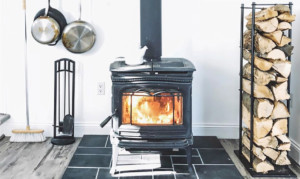 There’s no denying that an abundance of options for wood stoves can make the overall purchasing experience a challenging affair for the buyer. This is why it’s best to understand the structural and functional aspects before making the purchase.
There’s no denying that an abundance of options for wood stoves can make the overall purchasing experience a challenging affair for the buyer. This is why it’s best to understand the structural and functional aspects before making the purchase.
Importance of Wood Stove
More and more homeowners are getting wood stoves into their homes due to a set of highly convenient features. Although each element contributes remarkably, the most significant benefit is the fervent heat the wood stove provides. This heating equipment is skillfully developed to produce radiant heat, effectively warming its surrounding setting quickly. Furthermore, it’s equally vital to note that a wood stove exudes warmth in all directions for even distribution.
Wood Stove Buying Guide
Let’s Get Down To a Few Points To Help You Choose The Right Wood Stove for Purchasing –
- Identifying the Right Size Wood Stove
Most first-timers struggle to identify the right size for their new wood stove and best outdoor burner. This also compels them to go for the enormous stove available for sale. Most stoves are sold with huge fireboxes, which are as large as three to five cubic feet. Quite necessarily, those stoves yield high heat outputs.
It is essential to comprehend these heating stoves are ideal for generating heat in a particular corner of your setting. If you are willing to heat a space stretching up to 1,500 square feet, you must go for a wood stove with a firebox between 1.5 and 2 cubic feet.
- Improved Efficiency
There’s no denying that superior efficiency contributes to saving money on wood, minimal hauling or chopping wood, and ultimately an environment-friendly product. It’s essential to note that older wood stoves typically lose their efficiency. Your best choice for a wood stove must include EPA-listed efficiencies or above to leverage the equipment.
- New EPA Regulations for Clean Air
Much before the days of innovation and technology, people had to make do with smoke-belching stoves. Due to the latest clean air regulations, the wood stoves have checked their smoke emissions to keep them under 2.0 grams/hour. You could still come across companies pushing their old units under the radar for sale before the deadline. It would be best if you always keep an eye on the EPA emissions listing when shopping for the perfect burn.
- Catalytic
Back in the ’80s, when the wood stove was initially introduced, they used to feature catalytic combustors in their designs. This served the purpose of lowering smoke emissions. But they were heavily criticized since the catalytic combustors took forever to begin. Furthermore, they were prone to breakdowns, eventually going out of use after a few years.
Such is not the case with the latest catalytic stoves. They come as shiny clean with a promise for improved efficiency against the non-catalytic stoves. Additionally, the new-age equipment comes with ten years of service with room for more depending on the maintenance and usage.
- Scheduling Regular Cleaning
Lastly, it only mentions that wood stoves require exclusive maintenance, much like every other lifestyle equipment. You must develop a habit of cleaning the stove right before the winters commence each year. This is due to two primary reasons- a regular checkup will help your equipment function uninterruptedly.
Secondly, it’s generally tricky getting professional stove sweeps due to their ever-increasing demand. Please set a cleaning appointment right after buying the wood stove to have a guaranteed heating service in the future.
The Bottom Line
Here’s hoping that the pointers mentioned above will help you make a well-informed decision when selecting your wood-burning stove. You can go through this guide when making the purchase for the first time or for the umpteenth time in life.


